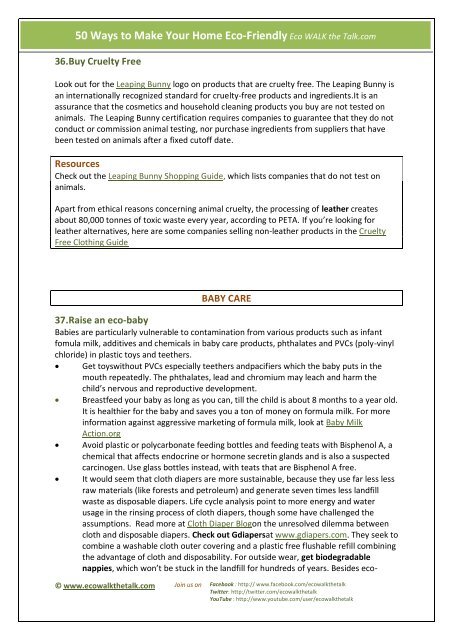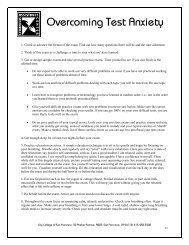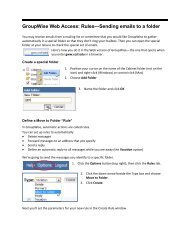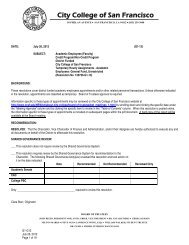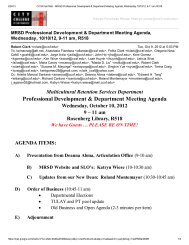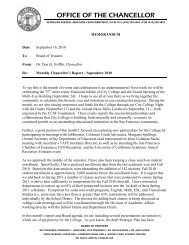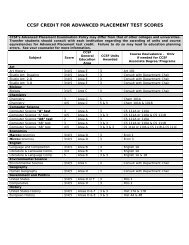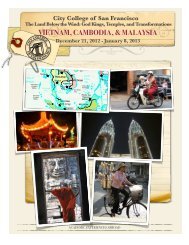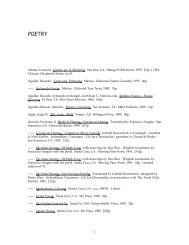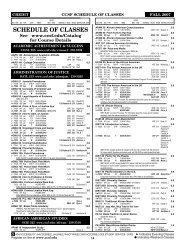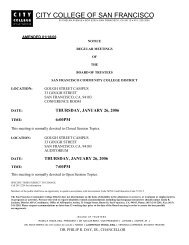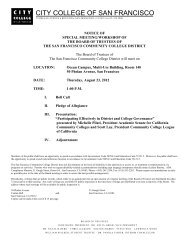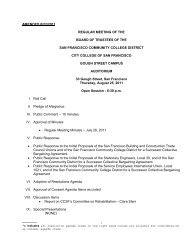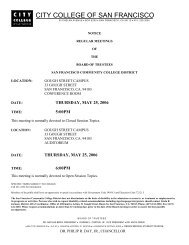Create successful ePaper yourself
Turn your PDF publications into a flip-book with our unique Google optimized e-Paper software.
<strong>50</strong> <strong>Ways</strong> <strong>to</strong> <strong>Make</strong> <strong>Your</strong> <strong>Home</strong> <strong>Eco</strong>-<strong>Friendly</strong> <strong>Eco</strong> WALK the Talk.com<br />
5<strong>50</strong> Wa<br />
36.Buy Cruelty Free<br />
Look out for the Leaping Bunny logo on products that are cruelty free. The Leaping Bunny is<br />
an internationally recognized standard for cruelty-free products and ingredients.It is an<br />
assurance that the cosmetics and household cleaning products you buy are not tested on<br />
animals. The Leaping Bunny certification requires companies <strong>to</strong> guarantee that they do not<br />
conduct or commission animal testing, nor purchase ingredients from suppliers that have<br />
been tested on animals after a fixed cu<strong>to</strong>ff date.<br />
Resources<br />
Check out the Leaping Bunny Shopping Guide, which lists companies that do not test on<br />
animals.<br />
Apart from ethical reasons concerning animal cruelty, the processing of leather creates<br />
about 80,000 <strong>to</strong>nnes of <strong>to</strong>xic waste every year, according <strong>to</strong> PETA. If you’re looking for<br />
leather alternatives, here are some companies selling non-leather products in the Cruelty<br />
Free Clothing Guide<br />
© www.ecowalkthetalk.com Join us on<br />
BABY CARE<br />
37.Raise an eco-baby<br />
Babies are particularly vulnerable <strong>to</strong> contamination from various products such as infant<br />
fomula milk, additives and chemicals in baby care products, phthalates and PVCs (poly-vinyl<br />
chloride) in plastic <strong>to</strong>ys and teethers.<br />
� Get <strong>to</strong>yswithout PVCs especially teethers andpacifiers which the baby puts in the<br />
mouth repeatedly. The phthalates, lead and chromium may leach and harm the<br />
child’s nervous and reproductive development.<br />
� Breastfeed your baby as long as you can, till the child is about 8 months <strong>to</strong> a year old.<br />
It is healthier for the baby and saves you a <strong>to</strong>n of money on formula milk. For more<br />
information against aggressive marketing of formula milk, look at Baby Milk<br />
Action.org<br />
� Avoid plastic or polycarbonate feeding bottles and feeding teats with Bisphenol A, a<br />
chemical that affects endocrine or hormone secretin glands and is also a suspected<br />
carcinogen. Use glass bottles instead, with teats that are Bisphenol A free.<br />
� It would seem that cloth diapers are more sustainable, because they use far less less<br />
raw materials (like forests and petroleum) and generate seven times less landfill<br />
waste as disposable diapers. Life cycle analysis point <strong>to</strong> more energy and water<br />
usage in the rinsing process of cloth diapers, though some have challenged the<br />
assumptions. Read more at Cloth Diaper Blogon the unresolved dilemma between<br />
cloth and disposable diapers. Check out Gdiapersat www.gdiapers.com. They seek <strong>to</strong><br />
combine a washable cloth outer covering and a plastic free flushable refill combining<br />
the advantage of cloth and disposability. For outside wear, get biodegradable<br />
nappies, which won’t be stuck in the landfill for hundreds of years. Besides eco-<br />
Facebook : http:// www.facebook.com/ecowalkthetalk<br />
Twitter: http://twitter.com/ecowalkthetalk<br />
YouTube : http://www.youtube.com/user/ecowalkthetalk


